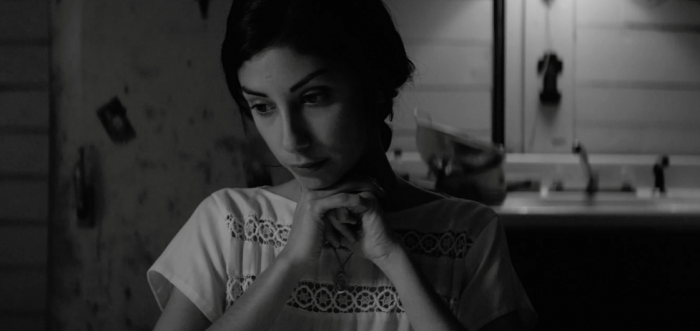
So long as disreputable film genres exist, there will always be a host of arty, “reputable” counterexample titles. Enter The Eyes of My Mother, a sporadically striking debut feature from Nicolas Pesce, which aims to wed austere, monochromatic pictorial grace with tactile, gruesome torture-horror, oscillating strenuously between extremes of beauty and ugliness. Three cryptically-titled chapters — “Eyes”, “Mother” and “Family” — trifurcate the film’s tale of Francisca (played in childhood by Olivia Bond and later by Kika Magalhaes as a grown woman) who as a child witnesses the murder of her mother by a male intruder on a farmhouse, before gradually devolving deeper and deeper into psychosis.
The opening sequence – later revealed to be a flash-forward – establishes a collapsed perspective. A handheld view from behind the wheel of a pickup truck, hurtling down a backwoods road, picks up in the distance a figure that is soon distinguishable as a live but bloodied body in the middle of the road. As soon as the driver stops to jump out of the car and investigate, we cut to a bird’s-eye-view surveying the elements of the scene before the title card appears. It’s an arresting prelude, establishing an unmoored POV that places the film in an unnerving dreamscape in which psychology is, by design, rudimentary, and characters are largely figural; its timeframe and location similarly vague.
The film that follows doesn’t entirely follow through on these gestures. Pesce can be commended for not padding out his runtime with noodly, atmospheric filler material, but the contrast of grisly, intimately tactile torture sequences with photogenic rural locales fast becomes a transparent pattern. Meanwhile, scattered scenes of conventional dialogue and exposition, combined with shaky supporting performances from certain cast members break the film’s oneiric spell. Its best moments are the least fussy, in which Pesce lets the physiognomy and physicality of his actors do the heavy-lifting. Bond and Magalhaes are both transfixing screen presences, and the latter’s Portuguese lilt add greatly to an already indelible soundscape. The initial home invasion sequence, meanwhile, benefits from the bug-eyed overacting of Will Brill as the murderer, evoking the first hitchhiker sequence in The Texas Chainsaw Massacre – a film whose poetry, by contrast, was a collateral (even accidental) result of a single-minded pursuit of the horror genre’s utilitarian purpose of frightening its viewer beyond all rationality.
“Rationality” is a key reason why The Eyes of My Mother doesn’t entirely work as a horror film. There’s no doubt that Pesce has all the right moves, but the film’s nightmare logic is far too neat, and its artistry wielded with too little discretion. It’s probably unfair to compare the work of a newcomer to an established master, but the comparison of Claire Denis’ Trouble Every Day (a possible model for Eyes) is instructive. With that 2001 film, Denis created a perfect synthesis of horror and art-film by wedding her recognisably elliptical, sensual style and chief interests of desire, sexuality and the body to content that just happened to be ridiculously grisly and horrifying — the film was a risky proposition, earning the worst reviews of her career at the time. The Eyes of My Mother, meanwhile, expertly fulfils its art and genre quotas, at the expense of any real pulse.
Around the Staff
| Megan Nash | |
| Luke Goodsell | |
| Tope Ogundare |
